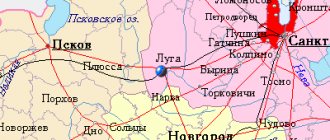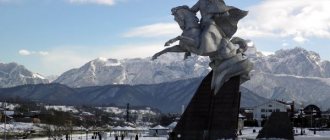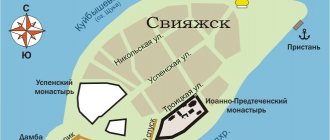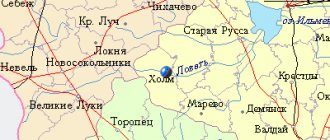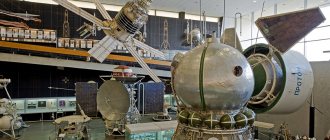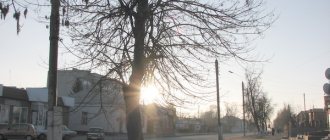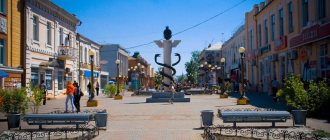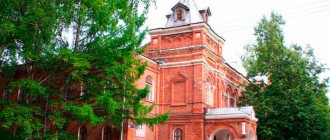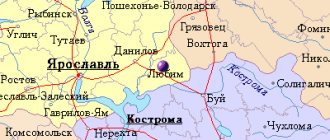One frosty February I wanted to go to some small town in the Moscow region. The choice fell on Zvenigorod , located 30 km west of Moscow. Despite its miniature size (population of only 20 thousand people and an area of about 50 km²), Zvenigorod has enough attractions, historical values and good landscapes to keep a curious tourist busy for the day.
Savvino-Storozhevsky Monastery in Zvenigorod
Zvenigorod is the oldest city in the Moscow region; According to archaeological data, already in the 12th century there was a settlement on this site, and according to chronicles the city was mentioned since 1382. Initially, Zvenigorod served Moscow as a defensive point; it is no coincidence that two fortresses were built here: a monastery and a Kremlin. Now it is a tourist city, also famous for its sanatoriums and clean air.
How to get to Zvenigorod
Several types of public transport run regularly to Zvenigorod and back.
Buses: Kuntsevskaya metro station - bus No. 452 Tushinskaya metro station - bus No. 455 Strogino metro station - bus No. 881
Electric trains: Electric trains depart every hour from Belorussky and Savelovsky railway stations.
You can also go with a transfer through the village of Golitsyno. Golitsyno is connected to Moscow by even more frequent trains, and from Golitsyno to Zvenigorod and back it is easy to get by regular bus No. 22.
Railway station in Golitsyno
The most inconvenient thing is that the railway station and the bus station are located in completely different places.
Railway station in Zvenigorod
Our journey around Zvenigorod begins from the railway station, which is located on the outskirts of the city. The entire station area is one big construction site! Seriously, everywhere you look, it's been excavated and fenced off.
From the station we decide to go straight to the Savvino-Storozhevsky Monastery - the main attraction of Zvenigorod. Despite the fact that the monastery is located outside the city, buses 23 and 51 go to it from the railway station.
References
Notes
- ^ a b c d f
Law No. 11/2013-OZ - ^ a b
Federal State Statistics Service of Russia (2011).
“All-Russian Population Census 2010. Volume 1" [All-Russian Population Census 2010, vol. 1]. All-Russian Population Census 2010 [All-Russian Population Census 2010]
(in Russian). Federal State Statistics Service. - https://www.gks.ru/free_doc/doc_2018/bul_dr/mun_obr2018.rar; archive date: July 26, 2022; received: July 25, 2022; Archive URL: https://web.archive.org/web/20180726010024/https://www.gks.ru/free_doc/doc_2018/bul_dr/mun_obr2018.rar.
- ^ a b c
Law No. 36/2005-OZ - "On the calculation of time." Official Internet portal of legal information
(in Russian). June 3, 2011. Retrieved January 19, 2022. - Post office. Information and computing center of OASU RPO. ( Post office
).
Search for postal facilities ( Search for postal facilities
) (in Russian) - Federal State Statistics Service of Russia (May 21, 2004). “The population of Russia, the constituent entities of the Russian Federation as part of federal districts, urban settlements, urban settlements, settlements, settlements of 3 thousand or more people.” [Population of Russia, its federal districts, federal subjects, districts, urban settlements, rural settlements - administrative centers, rural settlements with a population of more than 3000 people] (XLS). All-Russian Population Census of 2002 [All-Russian Population Census of 2002]
(in Russian). - “All-Union Population Census of 1989. The actual population of the union and autonomous republics, autonomous regions and districts, territories, regions, urban settlements and villages of the Grand Duchy of Moscow and the principalities of North-Eastern Rus' | Virtual exhibition dedicated to the 1150th anniversary of the birth of Russian statehood.” rusarchives.ru
. Retrieved July 17, 2022. - "Ivan Kalita". www.chrono.info
. Retrieved July 17, 2022. - Historical information - Zvenigorod Urban District. www.zvenigorod.ru
(in Russian). Retrieved July 17, 2022. - Korolev N. (May 29, 2014). "One day trip to Zvenigorod." Russia is beyond the headlines. Retrieved January 29, 2022.
- Kamalakaran, A. (29 July 2016). “4 Orthodox monasteries worth visiting near Moscow.” Russia is beyond the headlines. Retrieved January 29, 2022.
Sources
- Moscow Regional Duma. Law No. 11 / 2013-OZ of January 31, 2013 “On the administrative-territorial structure of the Moscow region,” as amended. Law No. 249 / 2019-OZ of November 29, 2022 “On amendments to the Law of the Moscow Region” On the administrative-territorial structure of the Moscow Region “”. Came into force the day after official publication (January 13, 2013). Published: “Daily News. Moscow Region,” No. 24, February 12, 2013 (Moscow Regional Duma. Law No. 11/2013-OZ of January 31, 2013. On the administrative-territorial structure of the Moscow Region.
As amended by Law No. 249/2019-OZ of November 29, 2019.
On amendments to the Law of the Moscow Region “On the administrative-territorial structure of the Moscow Region.”
Valid from the day following the day of official publication (January 13, 2013).
- Moscow Regional Duma. Law No. 36 / 2005-OZ of February 3, 2005 “On the status and border of the Zvenigord urban district,” as amended. Law No. 12 / 2010-OZ of February 26, 2010 “On amendments to the Law of the Moscow Region “On the status and border of the Zvenigorod urban district” and the Law of the Moscow Region “On the status and borders of the Odintsovo municipal district and newly formed municipalities within it” " Came into force on the date of official publication. Published: “Daily News. Moscow Region”, No. 26, February 12, 2005 (Moscow Regional Duma. Law No. 36/2005-OZ of February 3, 2005. On the status and border of the Zvenigorod urban district
As amended by Law of February 26, 2010 No. 12/2010- OZ.
On introducing amendments to the Law of the Moscow Region “On the status and border of the Zvenigorod urban district” and to the Law of the Moscow region “On the status and borders of the Odintsovo municipal district and the newly formed municipalities included in it”
. Valid from the date of official publication.).
Savvino-Storozhevsky Monastery
The Savvino-Storozhevsky Monastery was founded on Mount Storozhe in 1398 by one of the first and closest disciples of Sergius of Radonezh - the Monk Savva. Then it was one small wooden church and cell; The monastery acquired a stone temple, chambers and walls a little later in the 16th century.
The stop is called “Rest House of the Ministry of Defense”, the buses go further straight, and we go to the monastery to the right following the signs.
In front of the northern entrance to the monastery, in the park there is a monument to Savva Storozhevsky.
Monument to Savva Storozhevsky
The Savvino-Storozhevsky Monastery is the third most popular among pilgrims, after the Trinity-Sergius Lavra and the Seraphim-Diveevsky Monastery.
During its existence, the monastery has undergone many changes: from complete decline to the construction of a new architectural ensemble. Let's see what the Savvino-Storozhevsky Monastery is like now.
Walls and towers of the monastery
The territory of the monastery is surrounded by 760-meter stone walls 9 meters high and 3 meters wide with loophole windows located in three rows: for long-range combat, close combat and cannon attacks. The camps rest on seven military towers, one of which was dismantled in the 18th century. So, on the eve of the Russian-Polish War, the monastery turned into a military shield of Zvenigorod and Moscow.
The central Red Tower (or Gate Tower ) is decorated with remains from the 17th century. images of the Mother of God and the Venerables Sergius and Savva. Under the Red Tower there is the main entrance - the Holy Gate , which has now been closed. In 1883, a church was installed above the Red Tower in the name of Alexy, the Man of God .
Red Tower
The northeast tower is to the right of the Red Tower. The spiers of the towers are decorated with a trumpeting angel; we saw a very similar Siberian angel during our trip to the Tobolsk Kremlin.
Northeast Tower
The provision tower was presumably named so because of the food for the army that was stored in it.
Provisions Tower
Now in the Provision Tower there is a store with monastery baked goods and a small refectory for visitors on the second floor.
Provisions Tower
Here you can buy bread, cakes, gingerbreads, cakes, rolls, cookies, straws, etc.
It can be seen that the inside of the tower was put in order not so long ago, the walls were painted by hand, even the air conditioners were disguised, trying to convey the spirit of the past as much as possible.
The cafeteria on the second floor is quite cozy: small tables in wall niches, illuminated stained glass windows. The food here is delicious, although all the dishes are Lenten (it’s a monastery), and the prices are Moscow prices: a portion of borscht without meat costs 120 rubles. And pay attention to the full rack with alcohol; by the way, we never found alcohol-free mead in the monastery. But we enjoyed sbiten and delicious pastries!
Zhitnaya Tower , which served as a grain warehouse.
Zhitnaya Tower
South Tower (or Usova Tower )
South Tower
The southeast tower is for household needs.
Southeast Tower
Inside the walls of the Savvino-Storozhevsky Monastery
The refectory , built in 1652-1654, originally had four floors (including one basement) and a large dining room. At that time, the refectory was simply a miracle of construction: in the basement of the building there was an icehouse and a well, glass was inserted into the windows instead of mica, and the room was heated with warm air rising through special pipes. The monastery treasury was located on the top floor of the building. After reconstruction in the 19th century, the refectory decreased in height and lost its cross vaults.
Refectory of the Savvino-Storozhesky Monastery
Opposite the refectory, since 1998, on the site of the altar of the Church of St. John Climacus, dismantled in 1782, there has been a chapel-gazebo . For some reason it is forbidden to enter it.
Chapel on the site of the Church of St. John Climacus
From the side of the cathedral square, the belfry and the Church of the Transfiguration are closely adjacent to the refectory. In the photo below you can see the beautiful entrance to the refectory through the bell tower.
The four-tiered belfry was built in the 17th century. From 1671 to 1941 The belfry was decorated with the main symbol of Zvenigorod - the 35-ton Annunciation Bell, cast in the same monastery on the cathedral square in 1668. For three years the bell waited in the wings when it would finally be raised and fixed on the bell tower. In 1941, during the war, the bell was broken. In 2003, a new 37-ton bell was cast in Voronezh, which now adorns the middle tier of the belfry.
The Church of the Transfiguration was added to the refectory in 1693.
Church of the Transfiguration
The Gate Church of the Life-Giving Trinity is considered one of the first buildings of the 17th century (1651). In 1807, at the expense of Natalia Vladimirovna Sheremeteva, a refectory with a chapel in honor of the Kazan Icon of the Mother of God was added to the church. It turns out that there are two refectories in the monastery: one for monks, the second for nobles?
The lower part of the tongue of the large Annunciation Bell lies here.
The Cathedral of the Nativity of the Blessed Virgin Mary was erected in 1405 during the life of St. Sava on the site of the first wooden church. In December 1406, the Monk Savva died. In front of the temple, under a layer of snow, the ruins of the gate church of St. Sergius of Radonezh are preserved. In the Cathedral of the Most Holy Theotokos there is a shrine with the relics of Savva Storozhevsky.
Cathedral of the Nativity of the Blessed Virgin Mary
To the right of the Cathedral of the Blessed Virgin Mary is the very modest Palace of Tsar Alexei Mikhailovich Romanov with separate chambers for each member of the royal family. Construction of the palace began in 1652 and dragged on for almost 20 years, during which the building was rebuilt several times. The monastery has long been a favorite place of prayer for many Russian tsars, but it was under Alexei Mikhailovich Romanov that the Savvino-Storozhevsky Monastery was given the status of the first Lavra in Russia, and it began to be considered the residence of Russian sovereigns. The Tsar’s Road, now known as “Rublyovka,” was built from Moscow to the monastery, along which pilgrimages were made to the relics of Savva Storozhevsky.
Palace of Tsar Alexei Mikhailovich Romanov
At the southern wall of the monastery there are fraternal buildings: a small cell building and a large fraternal building . Initially, it was one large building, built in the 17th century, at a time when the number of monks reached 300 people.
Small cell and large fraternal corps
In the 19th century, part of the large fraternal building was dismantled and a small cell building was built in its place.
Small cell building
An upper floor was built over the remaining part of the large fraternal building, in which there was a hospital, a pharmacy and a fraternal almshouse. Currently, the buildings are occupied as cells for the brethren of the monastery.
Large fraternal corps
The final building around the Cathedral of the Nativity of the Blessed Virgin Mary is the Tsarina's Chambers . The elegant white and red building was built in the middle of the 17th century for the wife of Alexei Mikhailovich Romanov, Tsarina Maria Ilyinichna Miloslavskaya.
Tsarina's Chambers
The queen's chambers were located in the central part.
Tsarina's Chambers
For the queen’s convenience, the chambers were connected by a passage to the Trinity Gate Church, which became the home church of Maria Ilyinichna. Now the chambers house exhibitions of the Zvenigorod Historical, Architectural and Art Museum , as well as boyar chambers restored by restorers.
The last building that we approached on the territory of the monastery was the Treasury building , which stood at the eastern wall not far from the exit. It was built in the middle of the 17th century for the residence of those accompanying the king. The management of the monastery's economy was also carried out from this building, hence the name. Now it is also a museum building.
Treasury Corps
Other buildings around the Savva-Storozhevsky Monastery
Near the Savva-Storozhevsky Monastery there are several points of interest to visit. Directly opposite the northern gate and the monument to Sava you can see four multi-colored houses - the monastery hotel . True, now only the green building on the far right plays the role of a hotel.
Monastery Hotel
This building is now occupied by the Zvenigorod Historical, Architectural and Art Museum.
Zvenigorod Historical, Architectural and Art Museum
It is unclear who received the far left building. It was built almost on a slope, next to the observation deck.
And here is the observation deck itself. The view is so-so, probably better in summer. But now, through the bare birches, the fence of the well of St. Savva of Storozhevsky is clearly visible.
Lookout at the walls of the Savvo-Storozhevsky Monastery
The well was dug by Savva Storozhevsky in 1400. Later, a spring opened at this place, the water in which is considered healing.
Descent to the well of Savva Storozhevsky
To the north, about a kilometer from the monastery are the Skete , the temple of St. Savva Storozhevsky , the holy cave of St. Savva Storozhevsky and the bathhouse .
Equestrian farm Dyutkovo
Website: dutkovo.ru Address: Dyutkovo, 10
The courtyard has an interesting location: the equestrian club is located on the site of a bowl where a meteorite fell millions of years ago. There are no more than ten horses here each season. But the trails pass through places with an abundance of clean springs, where animals feel calm. Tourists often meet foxes, squirrels and birds along the road.
Participants in horseback riding are taught not only how to properly sit in the saddle. The program includes an introduction to the flora and fauna of the Moscow region and elements of orienteering.
Zvenigorod Kremlin (Gorodok) and the Cathedral of the Assumption of the Blessed Virgin Mary
From the monastery we return to Zvenigorod: one stop back along the Ratekhinskoe highway, and now we see a strange crowd of people. It turns out that they were drawing water from a spring.
From this moment the territory of the ancient Zvenigorod Kremlin begins. The Zvenigorod Kremlin is a unique historical monument of the 12th century; it was at this time that the first settlement with earthen and wooden fortifications arose here. Now the Kremlin is called “The Town”.
Town. Zvenigorod
During the reign of Prince Yuri Dmitrievich Zvenigorodsky (son of Dmitry Donskoy), who inherited Zvenigorod according to his father’s will, the city was fortified with a system of earthen ramparts up to 8 m high. The outer side of the ramparts was covered with clay, and the angle of inclination was up to 70 degrees. It was enough to lightly pour water on this side to make it impregnable to the enemy. Along the crest of the shaft, powerful wooden walls with towers were installed.
There are signs everywhere prohibiting skiing and walking on earthen slopes, so as not to roll them out, but it seems that nothing can stop a Russian person. These magnificent reliefs beckon! Moscow could long ago have dug up similar hills on some suburban wasteland and built a ski slope there.
In 1395, in the very center of the Kremlin, at the direction of the prince, a wooden tower-palace was erected, and about four years later, next to it, the stone Cathedral of the Assumption of the Blessed Virgin Mary , which has survived to this day almost in its original form. Unfortunately, it was not possible to capture the cathedral in all its glory - the roof was being repaired.
Cathedral of the Assumption of the Blessed Virgin Mary
Church of the Epiphany was built next to it , which was burned in the 30s of the 20th century. In 2003, construction of the current church was completed on the same site.
Church of the Epiphany
Right there on Gorodok we saw several private houses and administrative buildings. Some people are lucky to live in such a place rich in history.
Distinctive features of the city
Zvenigorod, whose sights were glorified back in the 12th century, is today a popular destination for vacationers. Forests, lakes and groves invite people to constantly return and relax their soul and body; thanks to these needs, the surroundings of Zvenigorod are equipped with a variety of resorts and boarding houses.
Features of Zvenigorod:
- Climate. Located in the central Russian zone, the city has moderate continental temperature conditions. In Zvenigorod, all 4 seasons of the year are clearly expressed, with a characteristic abundance of precipitation.
- Ecology. There are no hazardous industries or environmentally polluting enterprises on the territory of Zvenigorod and its environs. Highways and highways - Riga and Minskoe highways - are located at a distance from the city, separated by a forest belt, therefore, in environmental terms, Zvenigorod has the most advantageous position.
- Population. According to the latest census data, about 22 thousand people live in Zvenigorod. Mostly the population has Russian roots, but there are also representatives of more than 100 nations of the world, including citizens of both near and far abroad.
- Flora and fauna. In the forested areas surrounding Zvenigorod, as well as in protected reserves, there are more than 180 representatives of the flora and 80 species of animals and birds, some of which are listed in the Red Book.
House and linden tree of A.P. Chekhov
Coming out of Gorodok onto Krasnaya Gora Street, we immediately come across the former house of Anton Pavlovich Chekhov . I think everyone is familiar with his stories, which are interesting to read at any age, but not everyone knows that Anton Pavlovich worked as a doctor in Zvenigorod. This happened in 1884, when the local doctor Uspensky was forced to take a vacation for a month, and in return he asked Anton Pavlovich to work for himself. At that time, Chekhov graduated from Moscow University and was just beginning his writing career. This is what he wrote to a friend about his life in Zvenigorod:
● from a letter to N.A. Leikin dated June 25, 1884: “...They offered me a position as a zemstvo doctor in Zvenigorod - I refused...”
● from a letter to N.A. Leikin dated July 14, 1884: “Currently I am in the city of Zvenigorod, where, by the will of fate, I am filling the position of a zemstvo doctor, who asked me to replace him for 2 weeks. Half the day I am busy receiving patients (30–40 people a day), the rest of the time I relax or am terribly bored, sitting by the window and looking at the dark sky, which has been pouring for the 3rd day now, bad, non-stop rain... In front of my window there is a mountain with pine trees, to the right the house of the police officer, even to the right a lousy little town that was once a capital city... To the left is an abandoned rampart, to the left is a small forest, and from behind the latter the consecrated Savva peeks out. The back porch, or rather the back door, near which it smells like a toilet and a pig grunts, looks out onto the river.”
● from a letter to N.A. Leikin dated mid-July 1884: “...Or do this: go to the second station of the Smolensk road, Golitsyn. From here to Zvenigorod (15 versts) on horseback. In Zvenigorod we will see the consecrated Savva and drive from here to New Jerusalem (20 versts). All this will take you no more than a day. Grab Palmin. I warn you in advance: you will not find any amenities along the way... The roads and cities are worse than the worst, but there is a lot of fictional material. If you spend the night with me, I’ll take you to the hospital for an appointment (story in 300 lines). On Elijah, the 20th, I will have 60 sick people, on the 22nd 40 people. You will do better if you start your journey in Zvenigorod. The roads are bumpy, but picturesque..."
Chekhov's house in Zvenigorod
Chekhov's house in Zvenigorod
Rounding the house of A.P. Chekhov, we came across two brand new multi-colored buildings still under construction. First thought: “Probably a museum!” But no, it’s not at all clear what kind of buildings these are, for what purpose they were built and why one of them wants to push Chekhov’s house into a ravine?
Across Krasnaya Gora Street, on Oktyabrskaya Street, we found a stump with a memorial plaque. This is a former linden tree under which Anton Pavlovich loved to relax with his new acquaintance, the paramedic, Sergei Vasilyevich Barmintsev. The Chekhov linden tree a stump in 2013, when the old tree was first damaged by strong winds, and then completely broke due to snowfall.
Lipa Chekhova
Nearby, the house of the Barmintsev family has been preserved (one-story with carved platbands), where the descendants of paramedic Sergei Vasilyevich continue to live.
House of paramedic Barmintsev
Red Mountain Street
After visiting Chekhov's places, we go to the center of Zvenigorod. On the way up, Red Mountain Street is filled with private houses. I am glad that some modern houses fit well into the ancient Russian buildings. For example, the houses opposite Chekhov's house.
There are some(!) houses that are well looked after and maintained in appearance. Nice houses, but the fence ruins everything. I don’t even know which of these fences is worse.
Literally five meters later, a low-rise residential complex rises in front of us.
On the other side of the road is just some kind of golden palace of an Indian Raja.
I wonder if it’s normal for residents of a golden new building to see this from their window every day?
Or that?
Or this? By the way, in this terrible house from 1922 to 1941. the Zvenigorod planetary school was located , and then the flying club , whose cadets became pilots during the Great Patriotic War. Zvenigorod, aren't you ashamed?
Cultural Center named after Lyubov Orlova
Address: Moskovskaya street, 11
It is no coincidence that the only museum in the world dedicated to the Soviet actress was opened in Zvenigorod - it was in this city that Lyubov Orlova was born. The interior of the building is designed in the style of a black and white movie; in front of the entrance to the museum there is a monument to the actress. Among the exhibits: Orlova's costumes, personal belongings, portraits, wind instruments used in films.
Tourists and local residents are especially keen to visit the cinema hall at the museum. Here you can watch films with the participation of the famous actress and documentaries covering in detail the biography of Lyubov Orlova. On certain days, the museum's cinema hall hosts performances by pop artists and children's shows.
Museum of Russian Dessert
This garage cooperative, opposite the Golden House, houses the Museum of Russian Dessert and the Artist Feina's Workshop . To be honest, after reading conflicting reviews, we did not dare to go in: some were satisfied and want to come again, others complain about high prices and small portions. In any case, this place is on everyone’s lips in Zvenigorod.
What to bring as a souvenir
In Zvenigorod there is an unusual shopping complex, stylized as a Russian street from the mid-century. There are many shops on it where you can choose unusual hand-made gifts and souvenirs for any, even the most demanding taste.
Zvenigorod is a city filled with history; its attractions will leave an indelible mark on the soul after visiting.
I want to come back here and fill my heart with beauty and tranquility. The city with singing and ringing bells always welcomes guests.
Author of the article: Shishlina Anna
Article design: Svetlana Ovsyanikova
City Park
It's surprising that such a small town as Zvenigorod has its own city park.
This place is hardly suitable for a full-fledged park. The park has two illuminated alleys with benches, a children's playground can be seen in the distance, the Foundation Stone of the Memorial to Internationalist Soldiers , and a bust of V. I. Lenin . It is interesting to look at this park in summer.
Zvenigorod city park
Rest
In Zvenigorod you can relax not only by visiting historical monuments, but also by choosing a more modern way:
- Leisure. Fans of active recreation in Zvenigorod will find entertainment to their liking at any time of the year. In winter, the city and its suburbs have excellent ski slopes of various difficulty levels. Sports fishing competitions are held on the Dubeshnya River. You can also try yourself as a horse rider, taking exciting horseback rides around the city and surrounding area. In the summer, you can kayak down the Moscow River or take a helicopter tour, viewing the sights of Zvenigorod from a bird's eye view.
- Interesting places to relax with children. When visiting Zvenigorod with children in the summer, it is impossible to resist the temptation and refuse to look into the “Miracle Park”, located not far from the city. The entertainment provided by the park will appeal to children and adults of all ages. More than 50 attractions, gazebos, equipped places for fishing, themed playgrounds, a cafeteria, a cable car, sports grounds - this is a short list of what “Miracle Park” has to offer. This is a wonderful place for a family and friends holiday. The park begins welcoming guests in May, all days except Monday and Tuesday.
Church of the Ascension of the Lord
The Church of the Ascension of the Lord proudly rises on the hill. Since the 16th century, churches were built on this hill, which were later destroyed during times of fierce battles and unrest.
Church of the Ascension of the Lord. Zvenigorod
The first known description of the Ascension Church was found in scribe books for 1624. In 1792, a stone temple was built on this site, but it was destroyed by the French army in 1812. The temple was restored, but was completely closed in 1922; later it was used as a place for grain storage and bus parking. In May 1941, the temple was completely dismantled. In 1998, a small memorial chapel was erected here.
Church of the Ascension of the Lord. Zvenigorod
The current Ascension Cathedral was built in 2007 - on the 600th anniversary of the death of St. Savva Storozhevsky. The church building is a four-pillar, five-domed brick building in the neo-Byzantine style.
Church of the Ascension of the Lord. Zvenigorod
Church of the Ascension of the Lord. Zvenigorod
Moskovskaya street:
The center of Zvenigorod is defined by two main parallel streets, closed in a one-way traffic ring: Moskovskaya and Vasily Fabrichny (which turns into Ukrainian). The length of these streets is no more than two blocks, on which 1/3 of all the attractions of Zvenigorod are concentrated.
Due to the large congestion of cars, it is difficult to photograph historical houses.
And here it is not clear: either a new building, or a well-restored house.
Unexpectedly, in the dining room they bought Vyatka kvass, which had been advertised throughout the country. Not bad, but nothing more.
Geese and a snowman ride in a semi-barrel on wheels, harnessed by small reindeer. You can't just pass by.
Memorial to the Eternal Flame
Monument to the fallen Zvenigorod residents and soldiers of the Fifth Army of the Western Front and the eternal flame . In 1941, Zvenigorod defended the western part of the country and the approaches to Moscow: anti-tank ditches were dug, anti-personnel barriers were installed, and a fighter battalion was formed. When the Germans approached Zvenigorod at a critical distance and were practically celebrating victory, the Zvenigorod residents were able to stop the enemy at the northern gates of the city.
Monument to the fallen Zvenigorod residents and soldiers of the Fifth Army of the Western Front and the eternal flame
Monument to A.P. Chekhov
Across the road there is a wonderful monument to A.P. Chekhov - an exact copy of a photograph of Chekhov in Melikhovo with his dachshund Khina from 1897.
Cultural Center named after. L. P. Orlova
Lyubov Petrovna Orlova (1902 - 1975) is a domestic film star of Hollywood proportions. She played on the stage of the theater and starred in films: “Jolly Fellows”, “Circus”, “Volga, Volga”, “Spring”, etc. Orlova for many years was the prima donna of the Soviet film screen, distinguished by her exquisite aristocratic appearance and well-groomed appearance. This talented woman was born and raised in Zvenigorod, it is not surprising that an entire cultural complex was built in her honor.
Cultural Center named after. L. P. Orlova
Monument to L.P. Orlova
Purchase yard
An interesting modern place in Zvenigorod is Kupchiy Dvor . This is a row of houses in the spirit of the 19th century, which sell various designer items, fashionable clothes in the Russian style, and host master classes. In general, you can come here just like visiting a museum and have a pleasant time!
Merchant's yard. Zvenigorod
Merchant's yard. Zvenigorod
Merchant's yard. Zvenigorod
Alexander Nevsky Church
The church was built in 1902 by decision of the Zvenigorod assembly in honor of Emperor Alexander III. In 1938, the temple closed, but its fate was not as sad as that of the Ascension Church: the building was rebuilt to meet the needs of other institutions, but was not destroyed. After the return of the church building in 1991, several stages of restoration and restoration work were carried out to return to its original appearance.
Church of Alexander Nevsky. Zvenigorod
Church of Alexander Nevsky. Zvenigorod
Church of Alexander Nevsky. Zvenigorod
It was strange to see a children's playground in the churchyard. This is probably due to the fact that there is a children's Sunday school and library on the church premises.
Church of Alexander Nevsky. Zvenigorod
Monument to Prince Yuri Zvenigorodsky and Savva Storozhevsky
The final attraction on Moskovskaya Street for us was the monument to the Russian prince Yuri Dmitrievich Zvenigorodsky and Savva Storozhevsky , about whom much has already been written. The monument was erected in 2005 on the 853rd day of the city.
Monument to Prince Yuri Zvenigorodsky and Savva Storozhevsky
So we walked from end to beginning all of Zvenigorod. It was a good walk and not at all tiring. Construction is in full swing next to the monument and the church; Zvenigorod is being built up with Moscow High-Rise buildings, and very chaotically and unceremoniously on historical sites.
Vvedenskoye Estate
The last point that we really wanted to visit before leaving for Moscow was the Vvedenskoye estate . Photos on the Internet promised us a whole estate ensemble, but in reality we were only expected to have a short conversation with the security guard: “by appointment only.” Complete disappointment!
Gate to the Vvedenskoye Estate
Now there is a sanatorium on the territory of the estate, and on the gate there is a sign with the rules of visiting: the excursion is conducted by a specialist from the sanatorium upon prior request by phone or email.
Rules for visiting the Vvedenskoye estate
There was nothing left to do but go to the station.
Zvenigorod. Entrance to the city
During our walk, we shot a short video about Zvenigorod: all the most interesting things about the city in two minutes. Enjoy watching and have a nice trip everyone!
Rent a Car
The offices of international rental companies closest to Zvenigorod are located in Moscow, so it would be wiser to rent a car in the capital and get to the city along Novorizhskoye, Mozhaiskoye or Rublevo-Uspenskoye highways. But if you find yourself in Zvenigorod and urgently need personal transport, you can use the services of local rental companies. Renting a compact car like a Hyundai Solaris will cost from 2,000 RUB, an SUV - from 3,500 RUB, a luxury car - 3,800-10,500 RUB per day.
Traffic jams in Zvenigorod are rare; minor congestion is possible only at the exit from the city. But parking can be a problem: there are many parking lots here, but they are almost always crowded. You can look for free space near hotels or in residential complexes.
